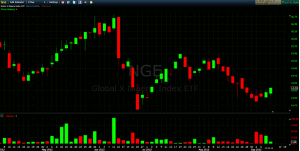The lion markets are now set to roar, and none more so than Nigeria, which has seen explosive growth over the last few years, writes trader Anna Coulling of AnnaCoulling.com.
For many traders and investors, searching out higher yields and higher returns in exotic currencies and markets has been fraught with danger. Whilst higher returns are certainly available, these returns come with associated much higher risks. In the last few months, the Brazilian real and the Indian rupee have been classic examples of hot money flows making these exotic currencies and many others extremely volatile.
The lion markets in particular are now set to roar, and none more so than Nigeria, which has seen explosive growth in equity markets over the last few years. Not only is it one of the largest countries in Africa by population, but is also the biggest oil producer on the continent with the commodity in demand worldwide due to its low sulfur content, often referred to as light sweet crude.
For domestic and international investors, the financial markets are now increasingly seen as offering many opportunities for traders, investors and speculators, and in the last few months, the first ETF was launched on the NYSE, providing exposure to this exciting market. Furthermore, Goldman Sachs has recently added Nigeria to its so called ‘Next 11′ list. This is a list of countries which it considers are potentially the fastest growing economies, and which are likely to be an important source of global economic growth in the future. No wonder all eyes are turning to the region.
With the Nigeria Index ETF fund (NGE) now shortly celebrating six months' trading history, technical traders finally have some meaningful charts to analyze price and volume and so forecast future market direction for the index. Indeed, since its launch in April this year, the ETF has provided some classic lessons in volume price analysis. Here we are looking at the two-day chart for the index.
The first of these was in the bullish phase of price action, which saw the index climb from the 14.60 region, up to a high of 16.75 before selling off sharply in the middle of June. The weakness in the move higher during May, was first signaled with the two ultra-high volume bars, both associated with weak price action in the form of shooting star candle, following by a narrow spread up candle.
For volume price traders, this was a clear warning signal of weakness ahead. The financial markets are much like the proverbial oil tanker, and when the engines are stopped, the tanker will continue for several miles under its own momentum. Such is the case with the markets. The bullish momentum continued, but at a slower pace, with a much deeper shooting star candle, associated with high volume, and finally, in the middle of June, and extreme volume bar appeared on a relatively narrow spread candle. A further sign of weakness, and merely confirming that the market was topping out with the market makers selling into the rally at this level.
Finally the market broke lower, with a wide-spread down candle, but note the volume, low on both candles, sending a clear signal that this reversal, was not going far. The market duly rallied and then reversed once again, all on average or low volume, which is much as expected in the summer months. The question now, is where next for the index?
Since mid August, the index has been bearish, but in the last few days, we have finally seen the first signs of buyers coming into the market at the 13.90 level with well above average volume and narrow spread down candles. At the same time, this has created a platform of support in this region which now appears to be holding firm. Volumes over the last two-three days have been well above average, and with buyers now returning to the market, we can expect to see the ETF climb in the short-to-medium term, possibly back to test the 15.50 region of late July, where a sustained level of price resistance awaits. For a further move higher, volumes here will need to be well above average to propel the index back to retest the 16.75 in the medium term.
By Anna Coulling, Professional Trader & Blogger, AnnaCoulling.com






















